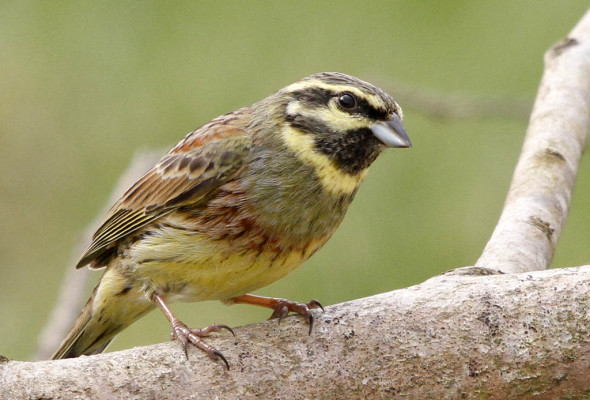Who are the animals that have most inspired people in 2013 to add their voices to the growing movement for animals? Leading up to the end of the year, AWP is celebrating the causes, campaigns and characters that have been at the forefront of helping make history for animals. Each day until the end of the year we’ll be focusing on another story. Please share far and wide.
Day 10: The Cirl Bunting
Not many of us outside the birdwatching community will know the cirl bunting. And not many of us living anywhere in the UK outside of Devon and Cornwall will have seen one.
But they are beautiful birds that look a bit like a small yellowhammer. The male has a bright yellow head, with a black crown, eyestripe and throat, and a greenish breast band across its otherwise yellow underparts. The female is much more like the yellowhammer, but has a streaked grey-brown rump and chestnut shoulders.
So 2013 was, in general, another year to celebrate for the cirl bunting, after good politics and land management through a reintroduction programme coordinated by the RSPB, Paignton Zoo, Natural England and the National Trust, led to a recovery in their numbers.
As discussed in the RSPB’s State of Nature report: “Once common across farmland in southern England, cirl buntings had declined to just 118 pairs in South Devon by 1989. Research by the RSPB revealed that these birds need mixed farmland, including suitable hedgerows or scrub for nesting, sources of seed throughout the winter and summer pastures rich in insects to feed their young.
“All these habitats were provided through agri-environment schemes, and the cirl bunting population increased significantly, to 862 pairs in 2009. Although these birds still depend on conservation efforts, the outlook is positive and shows that, through a combination of research, advocacy and management, conservation can bring species back from the brink.”
However, although such a recovery is worth celebrating, the cirl bunting population is still only a fraction of its former level. It is still restricted to just two counties (Devon and Cornwall), compared to the 38 English and Welsh counties where it could be found between 1875 and 1970.
And the cirl bunting remains endangered, especially when former partners in helping protect its habitat, the Devon NHS Trust, has willfully destroyed land to reduce its nature conservation value and make it easier to sell for development.
Mark Robins, the RSPB’s Senior Policy Officer in the South-West, explained in November: “The RSPB has worked at Hillcrest for 15 years in partnership with NHS locally. This has included an active volunteer engagement from among the local community to create high quality wildlife habitat especially for Cirl Bunting. It appears to us that a deliberate decision was taken to sacrifice the wildlife value to make it easier to gain planning permission for development.”
The Animal Welfare Party believes that ending the destruction of wildlife habitats, and subsequent extinction of endangered species such as the cirl bunting, should be made a top priority by government.
Can you make 2014 an even safer place for birds like the cirl bunting by becoming a visionary for animals? Support the Animal Welfare Party’s campaign in the EU Elections in May. If you live in London you can PLEDGE TO VOTE, and if you live anywhere and care about animals you can support us in our campaign to raise funds. Fundraising is crucial in our efforts to make history for animals. Make the difference now.
Image of cirl bunting © N Climpson







Leave a Reply